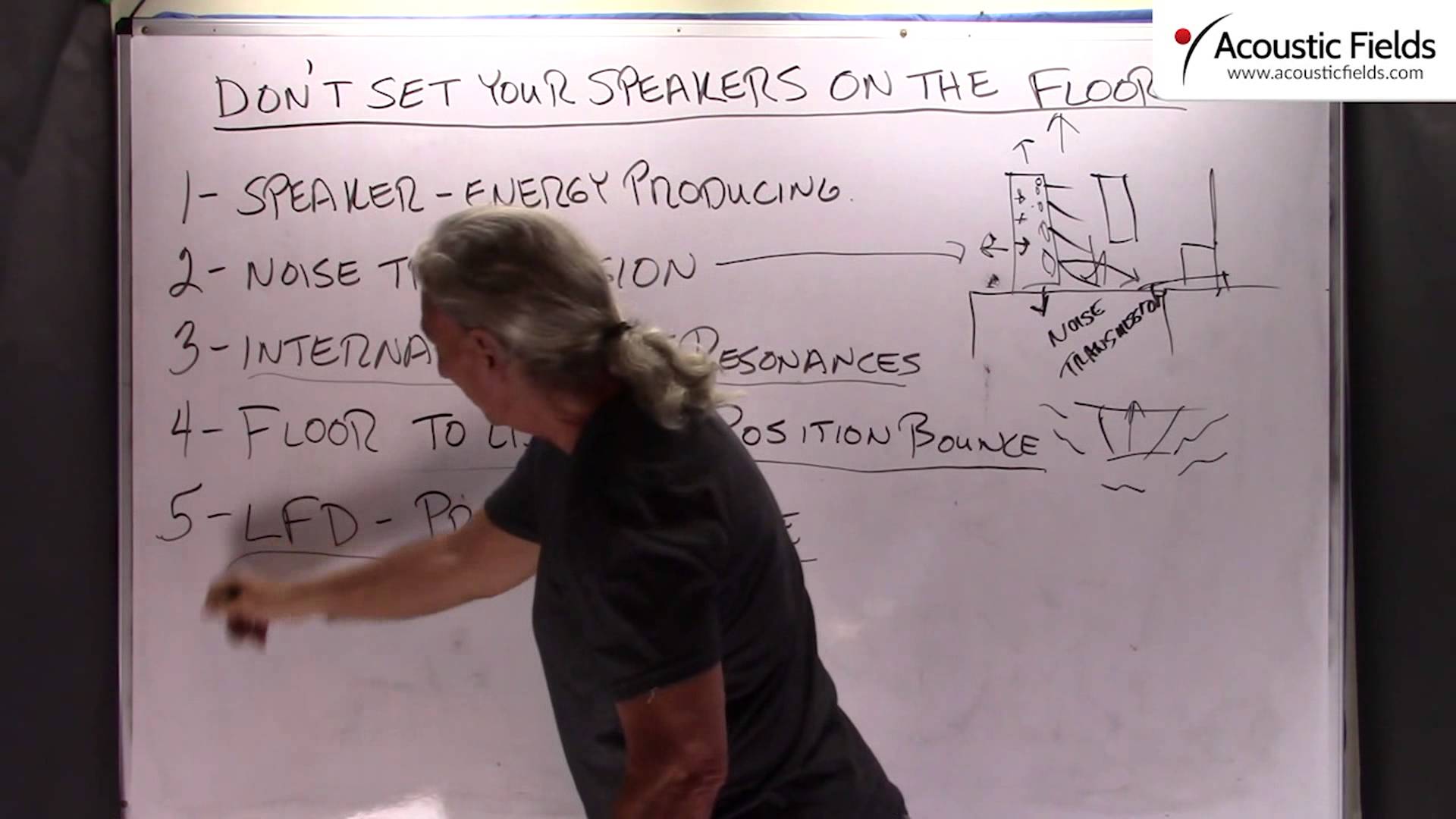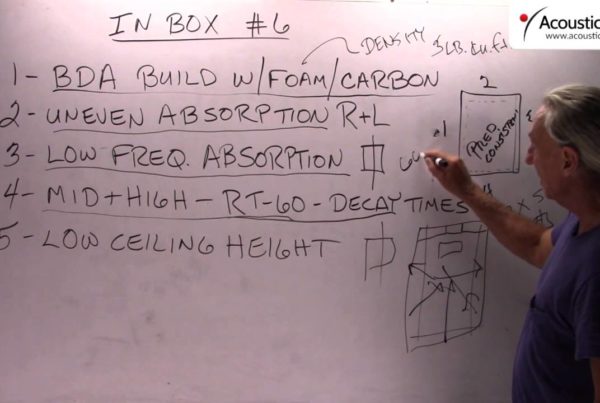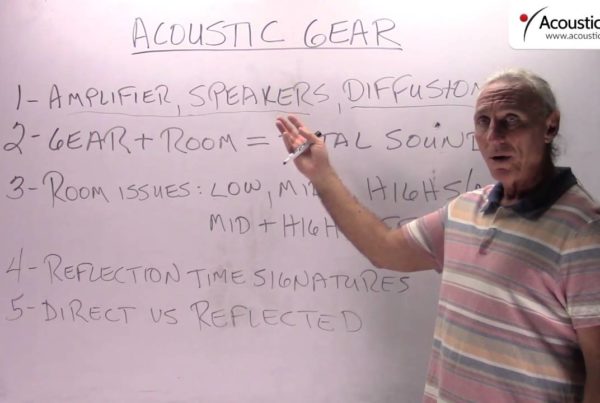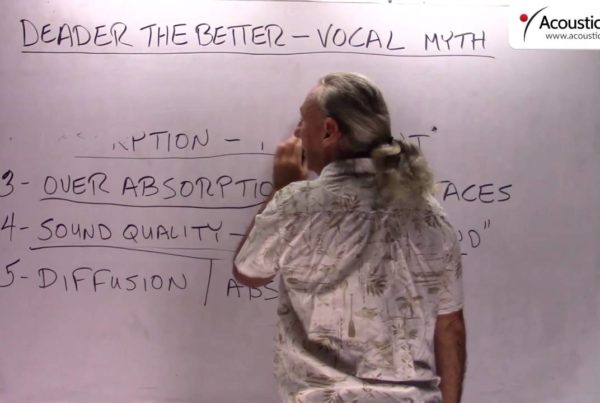Today we’re going to talk about how not to set your speakers on the floor. I wanted to deal with that in a bunch of different areas. So we can look at the ramifications of that statement.
Speaker – energy producing device. All right? So we have our speaker, we have our listening position. Okay? We have low frequency drivers, we have middle, we have high. Okay. So what do we know from our work with vibration, okay? That this is a huge energy producing device, the speaker. Okay?
So it radiates energy from all kinds of different directions. And then it has all these internal cabinet resonances. You want to feel how your speaker is designed and how well it’s designed? Just play some music through it and put your hands on it. You can feel the vibrations inside the cabinet. Well, if those vibrations are large enough and the frequency and the magnitude of those vibrations are strong enough they become audible.
So we have this huge device that’s shaking and rattling and rolling if you will right in front of us. So there’s going to be a lot of noise transmission from the actual cabinet to the floor structure itself, okay? So we’re going to have noise transmission from the cabinet into the source, into the floor, okay?
So with that noise transmission then we excite this whole floor structure and we get it to go what’s called diaphragmatic. And that’s no different than a speaker in your cabinet. So as the energy moves back and forth with the piston and all those vibrations are generated throughout the cabinet, the same thing can happen to the floor.
I’ve been in rooms that have 2 or 3 subwoofers and I can’t tell if the energy is coming from the subwoofer or the floor. The sound I mean. I can’t tell if it’s coming from the subwoofer or the floor. That’s how bad it is. So you have to be very, very careful with this huge energy-producing source and the noise that it’s transmitting to the structure. Okay? And we talked about the internal cabinet resonances. Okay.
Here is another thing you have to be careful of. The floor to listening position bounce. We know that the ceiling and the floor are our first reflection points. Why? Because we’re sitting on the floor obviously we’re closest to that surface and the ceiling is right above us. So by elevating the speaker above the floor you change that attack angle.
Now, you have to elevate your listening position, too but there are some spots in this ratio here of height with the speaker and height with the listening position that will actually smooth out the frequency response in the room and change the time signature of these reflections. And you have to work on it and you have to find it. And you also have to realize that there’s a low-frequency driver in most of these full range speakers.
So that low-frequency driver activates the pressure fields within the room. Now what are our pressure fields in the room? Floor to ceiling, front to back and then side to side. Okay? So you have to be cognizant of all these fields of energy within the room. And if you get the speaker off the floor, you get it more towards the center of the room or more towards away from a boundary surface then you’ll have a lot better chance of managing the pressure that generates from that.
So speakers and energy producing source. Remember that because it’s important, two kinds of energy, noise transmission and reflections that we have to be concerned about. It’s also a great area to include a low-frequency absorbing device. Diaphragmatic absorption, our favorite, pressure activated, you can’t get closer to the pressure than setting your speaker on a diaphragmatic absorber. And we have platforms on our website that you can look at for that.
So keep it in mind, think about your speaker as an energy-producing device it’s also a noise transmission device when it comes to structures, how do you minimize the vibration through the structures? You isolate and if you’re going to isolate with a platform you might as well absorb at the same time.
—
This is an unedited transcript from our video series from Acoustic Fields. There will be some errors in grammar and sentence structure that occur during this translation process.
For complete understanding and comprehension, please view the video which is included in this text. For any additional information regarding this topic or others relating to room acoustics, please contact us directly at:
P: 520 – 392 – 9486








Would the Allison Effect become problematic “if you get the speaker off the floor … away from a boundary surface”? My AR9 and AR90 loudspeakers (which rest on a concrete slab in my basement home theater) were designed such that the woofers are close to the floor and rear wall:
http://classicspeakerpages.net/library/acoustic_research/ar-9_series_1978-1981/ar-9_series_other/engineering_the_ar-9_by_tim/engineering_the_ar-9_by_tim_6.html
http://classicspeakerpages.net/library/acoustic_research/ar-9_series_1978-1981/ar-9_series_manuals/ar-9_manual/ar-9_manual_pg16.html
Hi Jim, Using SBIE to achieve more low frequency output is a quality versus quantity issue. Yes, you get more output but at the expense of sound quality. Decoupling the speaker from the floor surface will also reduce cabinet transfer energy to the floor. Floors can go diaphragmatic and produce noise.